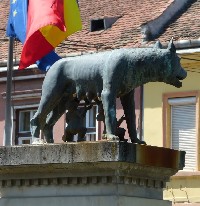Sighișoara
|
Sighișoara is a city on the Târnava Mare River in Mureș County, Romania. Located in the historic region of Transylvania, Sighișoara has a population of 28,100 Wikipedia |
Having the car played a part in our choice of accommodation. This had both advantages - we could be out of the town centre - and disadvantages - hotels we chose must offer parking.
On seeing the hotel in Sighișoara my heart sank. It was barely off the main road through town and the unattended entrance looked like the office of a travel agent. What one star accommodation could possibly be out-back. We couldn't raise anyone it was afterhours on a Sunday. Eventually a young woman appeared. Yes, I could park the car in their gated parking area at the end of the block. I left the bags with Wendy. When I got back and saw the room my spirits lifted. It was large spotless and recently renovated with a modern on-suite and kitchenette. Even a rustic view out the back.
Sighișoara - our rustic view out the back
The old medieval fortified town was a few minutes walk away and in another direction, along the river, a bridge provided a fine picturesque outlook along the river and access to the large Orthodox Cathedral, Biserica Sfânta Treime, with its dome looking more Roman than Greek. But inside clearly Orthodox.
As in other towns in Transylvania the historic church above the old town is Saxon and now Lutheran. To reach is is quite a climb and then you can descend through the very large graveyard, largely the burial place of German speaking residents, to judge by the inscriptions, all 'laid to rest' in expectation of the Second Coming.
There remains a vey small Germanic minority - less than 1.5% of the population
The old town is fascinating. It contains the only inhabited medieval fortress in Europe. The structure now called the clock-tower was obviously once the 'keep'. It protects the main gate, approached up a steep hill. It's massive and is separately fortified, with gun embrasures on all four sides. No use sneaking around behind.
It stands over the main gate, in which an incautious enemy could be trapped and attacked from above
It's now the City History Museum and provides excellent panoramic views of the town.
Sighișoara - from the clock-tower
Since the 17th century its featured a clock complete with iron shafts driving little carousels of rotating figures when it chimes. At different times it's served as a prison and there is a small torture museum in the dungeon cell dating back to the Holy Roman Empire no doubt, as have others we have seen around Europe. During that period the law was draconian and was enforced by torture, dismemberments and threats of those punishments.
Right: another Capitoline Wolf statue with Romulus and Remus beneath her
Since the original five copies were given by Italy to the newly united country of Romania in 1921
they have multiplied to 25 - without the intercession of the Gods
As already mentioned in Brașov, the gates and towers along the town's defences were the responsibilities of the town's guilds. In this case: butchers; tinsmiths; tailors; shoemakers; rope-makers; tanners and furriers. Most of these fortifications survive, providing additional medieval ambiance.
The old town quite compact and from a defensive point of view extremely well designed. The walls skirt higher ground, the nose of a substantial ridge pointing to the river, around which are fertile flats that would have provided food and materials to feed the town's commerce.
As we explored the area we kept coming across a bride and groom having their wedding photographs taken. A little bit of local colour.
From Sighișoara we drove to Sibiu (European capital of culture 2007) stopping at two more fortified Saxon churches and for lunch on the way.

